

Biomes of the World. Adaptation. Tropical Rain Forest Adaptations of Plants & Animals. Why are rainforests being destroyed? The Rainforest - Green / Earth Issues for Kids: Presented by Children of the Earth United, Green - Environmental Education for Kids, Teachers and Families. Rainforest Information for Kids. Rain Forest. In Brazil, which houses 30 percent of the remaining tropical rain forest on Earth, more than 50,000 square miles of rain forest were lost to deforestation between 2000 and 2005.

Biologists worry about the long-term consequences. Drought may be one. Some rain forests, including the Amazon, began experiencing drought in the 1990s, possibly due to deforestation and global warming. Efforts to discourage deforestation, mainly through sustainable-logging initiatives, are underway on a very limited basis but have had a negligible impact so far. The rain forest is nearly self-watering. Plants in the rain forest grow very close together and contend with the constant threat of insect predators. The National Cancer Institute (NCI) estimates that 70 percent of the anti-cancer plants identified so far are rain forest plants. Many trees and plants, like orchids, have been removed from the rain forest and cultivated.
Rainforest. Rain Forest Threats, Rain Forest Species. More than half of Earth’s rain forests have already been lost forever to the insatiable human demand for wood and arable land.

Rain forests that once grew over 14 percent of the land on Earth now cover only about 6 percent. And if current deforestation rates continue, these critical habitats could disappear from the planet completely within the next hundred years. The reasons for plundering rain forests are mainly economic. Wealthy nations drive demand for tropical timber, and cash-strapped governments often grant logging concessions at a fraction of the land’s true value. Rainforest Heroes. How Do Oil Spills Occur. The Living Rainforest The Living Rainforest.
Rainforest Biomes. The tropical rain forest is a forest of tall trees in a region of year-round warmth.
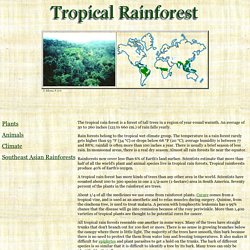
An average of 50 to 260 inches (125 to 660 cm.) of rain falls yearly. Rain forests belong to the tropical wet climate group. The temperature in a rain forest rarely gets higher than 93 °F (34 °C) or drops below 68 °F (20 °C); average humidity is between 77 and 88%; rainfall is often more than 100 inches a year. 7 Creative Apps That Allow Students To Show What They Know. 7 Creative Apps That Allow Students To Show What They Know by Tony Vincent, learninginhand.com While there are so many iPad apps that deliver content, one of the best uses for technology in education is to make something with what you’re learning.

This might include producing a video, authoring a digital book, recording a puppet show, creating a college, narrating a slideshow, designing a comic book, or somehow making your own media and study aids. Yes, there are loads of drill and skill apps, digital books, and electronic response systems that can be very useful in classrooms. VIF International Education Learning Center. Licensed for use on publications wholly owned by VIF International Education 3D Issue version 6.

Copyright (C) 2011 Trinity Innovations LTD. All rights reserved. World Biomes - 5th Grade Lesson Plan - VIF Learning Center Blog - VIF Learning Center. Habitats Photos. The resources below show photographs of sixteen different habitats, including deserts, mountains, coral reef, rivers and more.
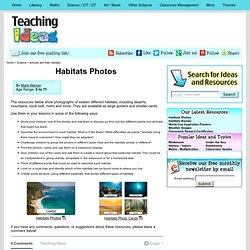
They are available as large posters and smaller cards. Use them in your lessons in some of the following ways: Show your children one of the photos and ask them to discuss (or find out) the different plants and animals that might live there. Describe the environment in each habitat. Teaching Ideas - Free lesson ideas, plans, activities and resources for use in the primary classroom. Science - Animals and their Habitats Teaching Ideas. Watching Snails!
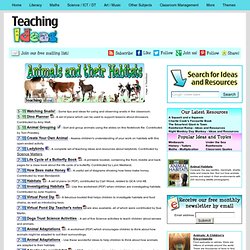
- Some tips and ideas for using and observing snails in the classroom. Dino Planner - A set of plans which can be used to support lessons about dinosaurs. Contributed by Amy Watt. Bill Moyers Reports: Earth on Edge - Ecosystems. Ecosystems are communities of interacting organisms and the physical environment in which they live.

Endangered Ecosystems: Build a Food Web. Biomes of the World - Biome Map. Click on a biome on the above graph for more information, informative videos, and links to scientist profiles, travel information, lesson plans and species profiles for each region.
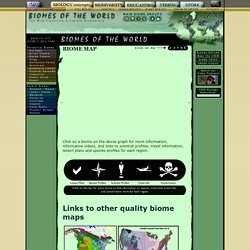
Biomes and Ecosystems. Food Web - Menu. Exploring Ecosystems. Gould League - Food Webs - build your own. A Walk in the Forest. Earth Floor: Biomes. There are many different kinds of plants and animals on the Earth, but only certain kinds are naturally found at any particular place.
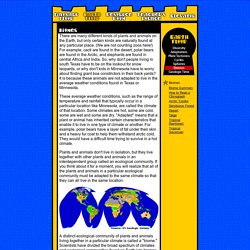
(We are not counting zoos here!) For example, cacti are found in the desert, polar bears are found in the Arctic, and elephants are found in central Africa and India. So, why don't people living in south Texas have to be on the lookout for snow leopards, or why don't kids in Minnesota have to worry about finding giant boa constrictors in their back yards? It is because these animals are not adapted to live in the average weather conditions found in Texas or Minnesota. These average weather conditions, such as the range of temperature and rainfall that typically occur in a particular location like Minnesota, are called the climate of that location. Plants and animals don't live in isolation, but they live together with other plants and animals in an interdependent group called an ecological community. Ornithos Atlantic Rainforest Webcam. World Land Trust uses cookies to make all features of the website work effectively, and they are essential if you wish to donate online.
Some cookies on this site are essential, and the site won't work as expected without them. These cookies are set when you submit a form, login or interact with the site by doing something that goes beyond clicking on simple links. We also use some non-essential cookies to anonymously track visitors or enhance your experience of the site. If you're not happy with this, we won't set these cookies but some nice features of the site may be unavailable. By using our site you accept the terms of our Privacy Policy. Journey to Planet Earth . Ecosystems. We are intimately familiar with ecosystems. They are the woodlands where we live, hunt, cut timber, or hike; the lakes, streams, and rivers we fish, boat, transport our goods on, and tap for water; the rangelands where we graze our cattle; the beaches where we play, and the marine waters we trawl; the farmlands we till; even the urban parks and green spaces we stroll. In effect, every centimeter of the planet is part of an ecosystem.
Welcome to Ecosystems for Kids! - BSC Science Treasures. Definitons Interesting Facts. Infopacket: Biomes. Scientists divide the world into large natural areas called biomes. Each biome is known for certain kinds of plants and animals. But what’s really at the heart of a biome is its climate. Mr. Mejia's 5th Grade Classroom / Ecosystems: Science Games. Ecosystems of Our World.
WebQuest. 5th Grade Science Introduction You have a new summer job working for a travel agent. You have been hired to create brochures and posters that will persuade travelers to visit a specific geographical biome. You have the opportunity to be extremely creative for the summer! Back to top The Task. Biomes Webquest - Mr. James 5th Grade.
Biomes - 5th Grade. Biomes and Ecosystems. Biomes and Ecosystems.